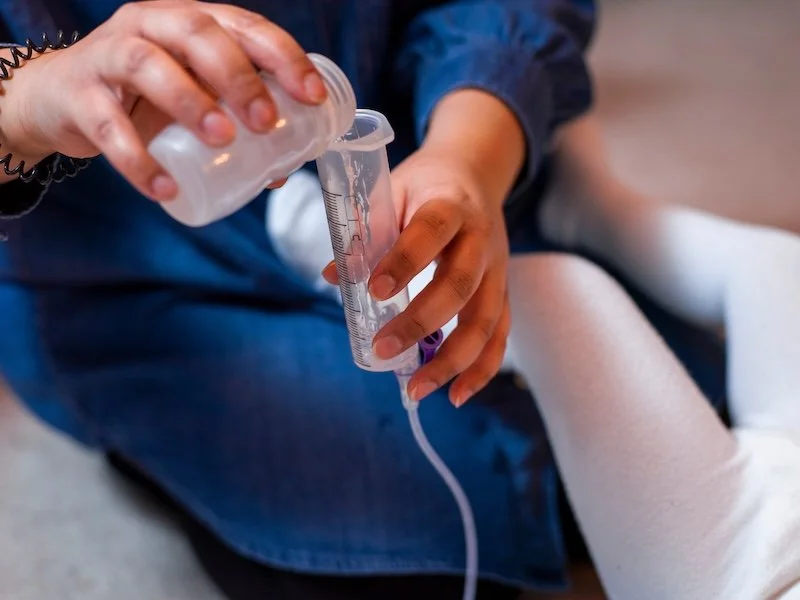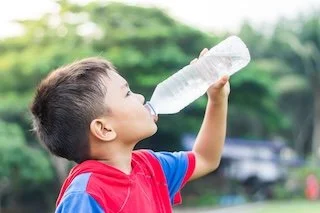Staying Hydrated with an Enteral Feeding Tube
-
Hydration is vital for individuals with feeding tubes, as fluid needs must be carefully monitored and managed. Unlike drinking by mouth, staying hydrated with a feeding tube requires scheduled water flushes, attention to daily fluid goals, and adjustments based on activity or illness. This blog explains why hydration matters, how fluids are delivered through a tube, signs of dehydration to watch for, and practical tips for caregivers and patients. With support from your healthcare team, staying hydrated can be safe, simple, and effective.
-
Why hydration matters: Prevents constipation, supports kidney function, and helps absorb nutrients from formula.
Signs of dehydration: Dry mouth, dark urine, dizziness, fatigue, skin changes, and constipation.
Ways to give fluids through a tube: Includes formula hydration, water flushes, bolus water feeds, and continuous water.
Common challenges: Reduced thirst, illness-related fluid loss, caregiver uncertainty, and environmental factors like heat.
Tips for success: Set a hydration schedule, track fluid intake, adapt for weather or illness, and work closely with your care team.
Special considerations: Children and older adults have unique hydration needs.
FAQ highlights: Water can be given through all types of feeding tubes; clean tap water is usually safe unless otherwise advised.
Staying properly hydrated is important for everyone, but when you have a feeding tube, it becomes even more essential to pay attention to your fluid needs. If you're like many people with feeding tubes, you might rely on your healthcare team, family members, or caregivers to help calculate and provide the right amount of fluids through your tube. This is quite different from simply grabbing a drink when you feel thirsty. Instead, your hydration needs to be thoughtfully planned and managed as part of your daily tube feeding routine.
Why Hydration is So Important for Tubies
When you have a feeding tube, getting enough fluids is essential and can be easily overlooked. Water helps your body use the nutrition from your formula and keeps your kidneys healthy. It also helps regulate your body temperature and prevents constipation - something many tube-fed people can experience.
Here are some signs you can watch out for that may indicate you need more fluid:
Dry or sticky mouth
Dark yellow urine (it should be light yellow)
Feeling tired or weak
Feeling dizzy, especially when standing up
Being more constipated than usual
Skin that doesn't bounce back quickly when pinched (check this on the back of your hand)
If you notice any of these signs, talk to your healthcare team and ask if you need to increase your fluid intake.
How Hydration Works with Tube Feeding
Your fluid needs depend on several things like your age, medical condition, and how active you are. Generally, adults need about 30-35 mL of fluid per kilogram of body weight each day, but children and people with certain medical conditions may need more or less fluid. Your healthcare team will calculate the right amount for you.
Holliday MA, Segar WE. The maintenance need for water in parenteral fluid therapy. Pediatrics. 1957;19(5):823-832.
There are several ways to give fluids through your feeding tube:
Formula with water: Most tube feeding formulas already contain water, so you're getting some fluid with your nutrition
Water flushes: Small amounts of water given before and after feeds or medications helps keep your tube clear and free from clogs
Bolus water feeds: Larger amounts of water given at specific times throughout the day
Continuous water: Water given slowly over time through a pump, just like continuous feeding
Always follow the hydration plan your healthcare provider or dietitian gives you. They know your specific needs best.
Common Challenges to Staying Hydrated with a Feeding Tube
Staying hydrated with a feeding tube can be tricky for several reasons:
Staying hydrated with a feeding tube can be tricky for several reasons:
You might not feel thirsty, so it's easy to forget about drinking enough fluids. If you can still drink by mouth, you might not be able to drink as much as before. Some medical conditions or medications can cause you to lose more fluid than usual - like vomiting, diarrhea, or sweating.
Many caregivers worry about whether they're giving enough water, which is completely understandable. Hot weather or being more active than usual can also increase your fluid needs, like everyone else.
Practical Tips for Staying Hydrated
Set a Schedule for Water Flushes
Create a routine for giving water through your tube. Many people give water before and after each feeding or medication. Having a set schedule makes it easier to remember and ensures you're getting fluids throughout the day.
Pay Attention to Weather and Activity
On hot days, during illness, or if you're more active, you'll need extra fluids. Talk to your healthcare team about how to adjust your fluid intake during these times. .
Keep Track of Your Fluids
Write down how much fluid you're getting each day. You can use a simple notebook, a phone app, or download our Hydration tracking sheet. This helps you and your caregivers see patterns and make sure you meet your daily goals.
Work with Your Care Team
Your healthcare provider, dietitian, or nurse can help you figure out the right amount of fluids for your situation. Don't hesitate to ask questions about your fluid needs, especially if you're sick, traveling, or changing your feeding schedule.
Special Considerations
Children have different hydration needs than adults and may need proportionally more fluids. Older adults are at higher risk for dehydration and may need extra attention to their fluid intake.
Call your healthcare provider if you:
Have signs of dehydration that don't improve with extra fluids
Are vomiting and can't keep fluids down
Have a fever, diarrhea, or other illness
Are unsure about how much fluid to give
Notice changes in urination or other concerning symptoms
Quick FAQ
Can you give water through any type of feeding tube?
Yes, water can be given through all types of feeding tubes (G-tubes, J-tubes, NG tubes, etc.). Your healthcare team will show you the best way to do this safely.
What type of water should be used?
Most people can use clean tap water, but individuals with a weakened immune system may consider using sterile or distilled water. Ask your healthcare team what is best for your situation.
What if vomiting happens after water flushes?
Try giving smaller amounts more slowly. If vomiting continues, contact your healthcare provider for guidance.
How can proper hydration help prevent constipation?
Adequate fluids help keep stool soft and make it easier to pass. This is especially important for tube-fed individuals who often struggle with constipation.
Staying hydrated is a crucial part of staying healthy when you have a feeding tube. While it might seem complicated at first, simple daily habits like scheduled water flushes and keeping track of your fluid intake can make a big difference in how you feel. Remember, you don't have to figure this out alone. Your healthcare team is there to help you create a hydration plan that works for your specific needs and lifestyle.
**Always consult with your healthcare team for individual medical advice. ***





